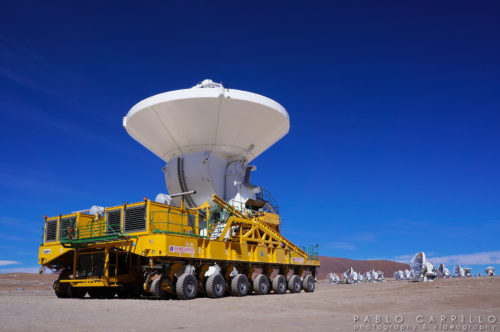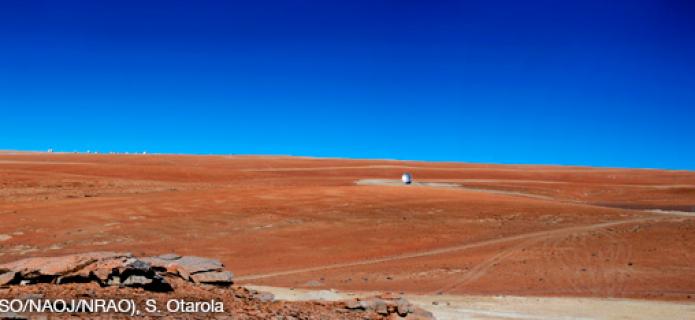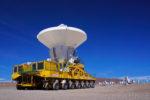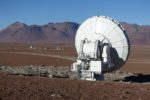ALMA Extends Its Arms
24 September, 2014 / Read time: 4 minutes
The Atacama Large Millimeter/submillimeter Array (ALMA) has successfully tested an antenna in the most extended configuration of the array yet, producing the longest baseline ever achieved by ALMA. This advance became possible once the first of ALMA's three extended arms was successfully powered up for the first time, and opens up the possibility of greatly extending ALMA’s capabilities. With longer baselines, the ability of a radio telescope to see fine detail increases, allowing astronomers to uncover much more information about objects observed in the Universe.

ALMA transporter moving a distant antenna Lore, one of ALMA’s two tailor-made antenna transporters, made its first journey along the Pampa la Bola arm and relocated an antenna to a distant pad. Engineers had to design vehicles rugged and durable enough to carry the antennas safely through the hostile desert environment. | ALMA (ESO/NAOJ/NRAO), P. Carrillo
Lore, one of ALMA’s two tailor-made antenna transporters, made its first journey along the Pampa la Bola arm and for the first time relocated an antenna to a position seven kilometers away from its furthest neighbour. This marks a major new technical achievement in the Atacama Desert in Chile, at more than 5000 metres above sea level. This new baseline is more than four times longer than is currently available to the ALMA scientific community, and tests of even longer baselines are in progress.
Catherine Vlahakis, Program Scientist for the ALMA Long Baseline Campaign says that: "successfully powering up an antenna for the first time over these long distances marks an important technical step towards increasing ALMA's ability to see objects in the Universe in fine detail".

A distant ALMA antenna This image shows an ALMA antenna on a distant pad in the Pampa la Bola branch, with Japanese ASTE and NANTEN2 telescopes in the background. | ALMA (ESO/NAOJ/NRAO), T. Sawada
Ed Fomalont, Lead Scientist for the ALMA Long Baseline Campaign, explains that "the combination of the signals from the antennas produces patterns called fringes. The fringes measured from the antenna seven kilometres away were as pure and strong as will be needed to obtain high quality images when additional antennas are moved to these long baselines."
Catherine Vlahakis, adds that "this is the first step in a process of moving several antennas out to these longer distances. Once the rest of the antennas are also in place we will be able to begin test observations of astronomical objects at higher angular resolution, and therefore in more exquisite detail, than ALMA has yet achieved."
Observations that will further test baselines as long as nearly 11 kilometers will continue over the next two months. If all goes as intended, this process will provide ALMA astronomers with the knowledge needed to offer long-baseline observations to the scientific community.
A distant ALMA antenna This video shows an ALMA antenna being moved to a distant location. The new seven-kilometer antenna separation is more than four times the longest ALMA baseline currently available to the scientific community. | ALMA (ESO/NAOJ/NRAO), E. Ormeño
More Information
The Atacama Large Millimeter/submillimeter Array (ALMA), an international astronomy facility, is a partnership of Europe, North America and East Asia in cooperation with the Republic of Chile. ALMA is funded in Europe by the European Southern Observatory (ESO), in North America by the U.S. National Science Foundation (NSF) in cooperation with the National Research Council of Canada (NRC) and the National Science Council of Taiwan (NSC) and in East Asia by the National Institutes of Natural Sciences (NINS) of Japan in cooperation with the Academia Sinica (AS) in Taiwan.
Contact:
Valeria Foncea
Education and Public Outreach Officer
Joint ALMA Observatory
Santiago, Chile
Tel: +56 2 467 6258
Cell: +56 9 75871963
Email: [email protected]
Richard Hook
Public Information Officer, ESO
Garching bei München, Germany
Tel: +49 89 3200 6655
Cell: +49 151 1537 3591
Email: [email protected]
Masaaki Hiramatsu
Education and Public Outreach Officer, NAOJ Chile
Observatory Tokyo, Japan
Tel: +81 422 34 3630
Email: [email protected]
Charles E. Blue
Public Information Officer
National Radio Astronomy Observatory
Charlottesville, Virginia, USA
Tel: +1 434 296 0314
Cell: +1 434.242.9559
Email: [email protected]


